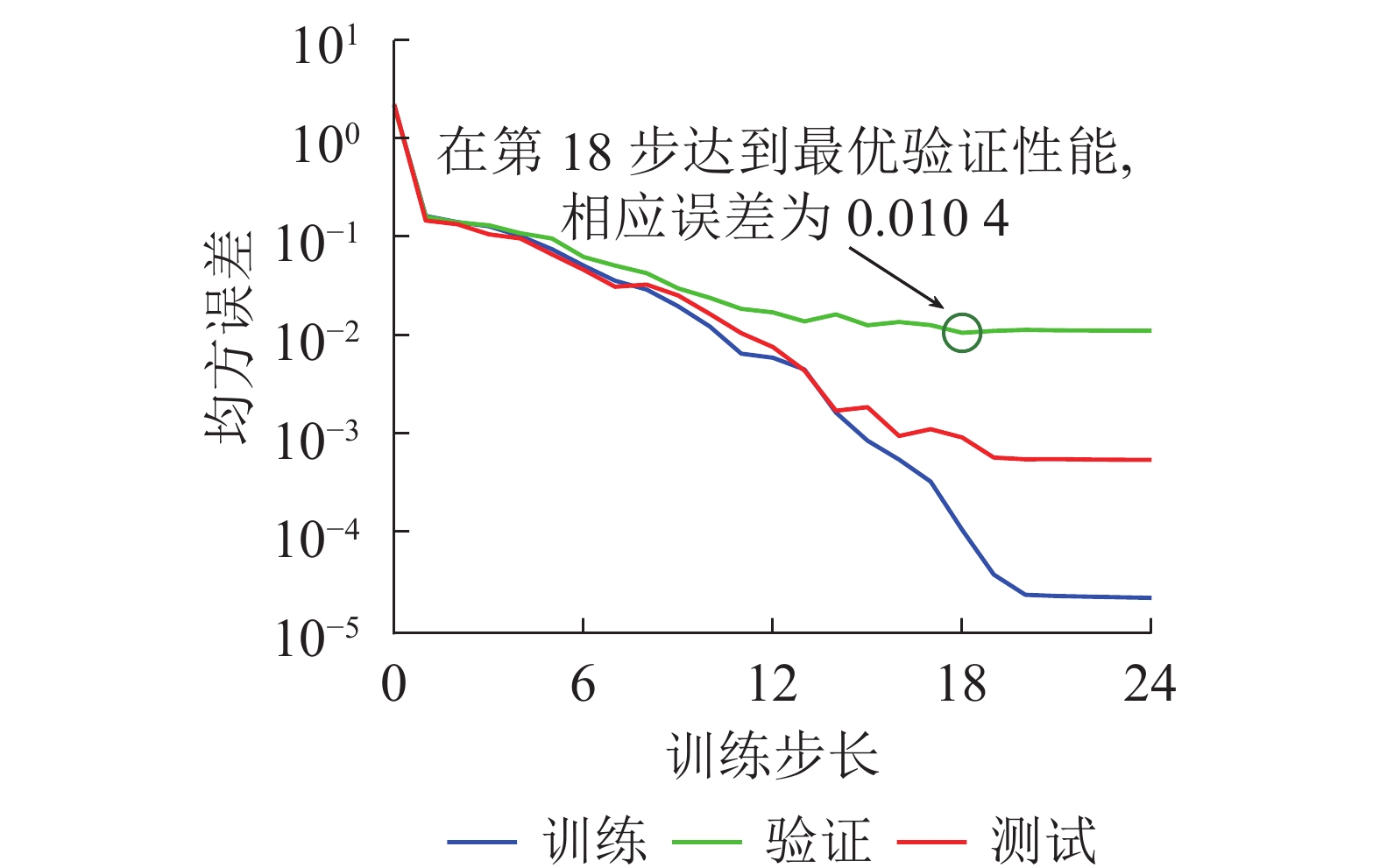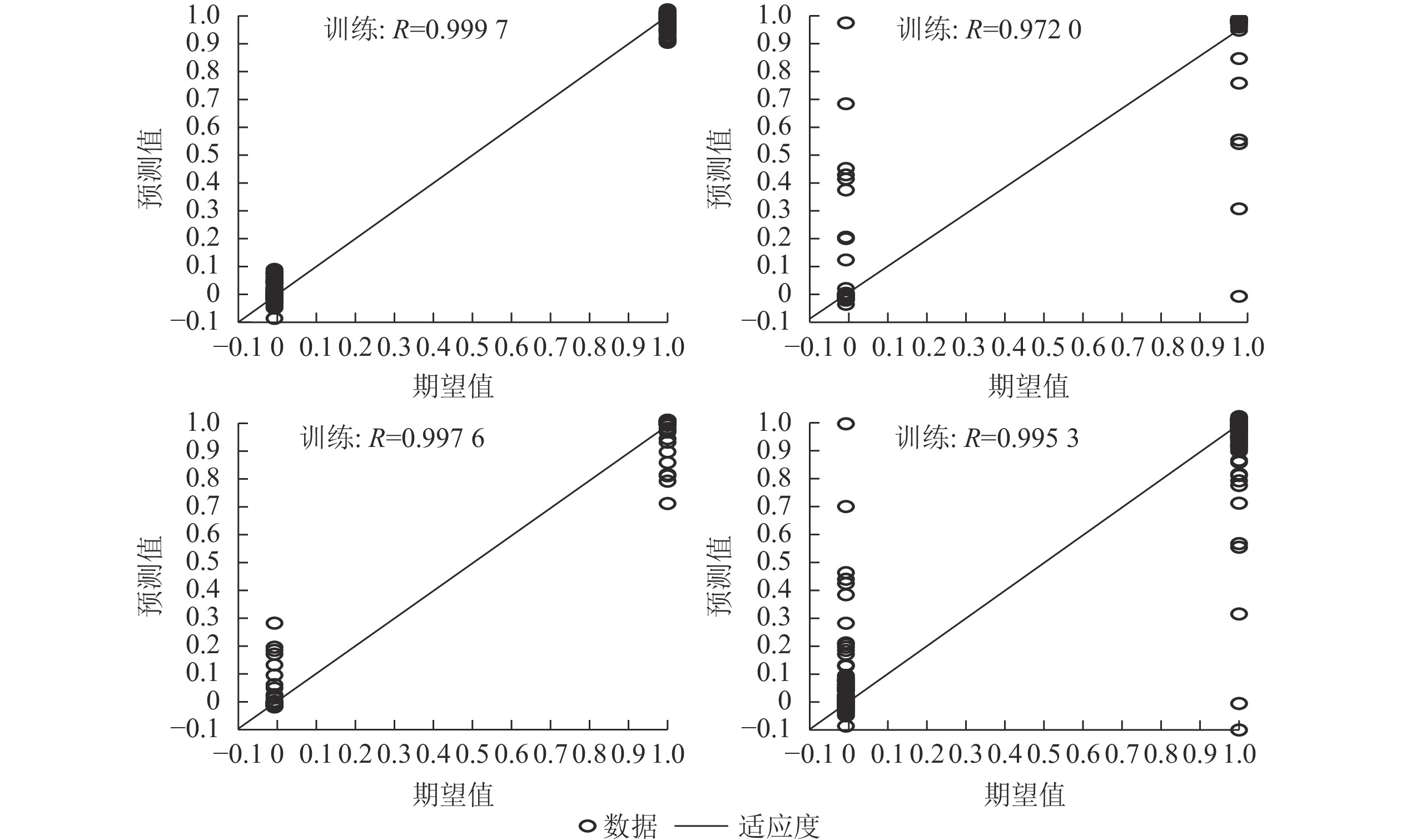-
洋白蜡Fraxinus pennsylvanica是中国重要的造林绿化树种,也是北京市使用频度最高的行道树种之一,其形体端正,枝叶繁茂而鲜绿,秋叶橙黄,不仅美观性强,还能捕获大量空气中的颗粒物,降低风速,改善城市空气质量[1]。行道树是城市绿地系统的骨干,以“线”的形式联系着城市中分散的“点”和“面”的绿化,构成完整的城市森林生态系统[2]。行道树在缓解城市热岛效应[3]、净化空气[4]、改善城市环境及维护城市内部生物多样性[5]等方面均能起到显著作用,其健康状况不仅反映了城市绿化质量高低,同时也是景观效果及生态效益得以发挥的重要基础。行道树易受人为活动的干扰,生长空间受限及后期疏于管护,易出现树势衰弱、腐烂空洞及病虫害频发等问题,存在较高的安全隐患,限制其景观和生态效益的发挥[6]。
近年来,层次分析法[7-9]、主成分分析[10-11]、综合打分法[12]、树木活力度分级[13]等方法广泛应用于树木健康评价中。不同评价方法各有优劣,评价结果精度也不尽相同,整体呈现出多方法相结合的发展趋势[14-16]。针对行道树开展健康评价研究,尚未形成实用性强的评价体系。基于此,本研究在北京市核心区11条街道洋白蜡行道树调查结果基础上,结合行道树生境、管护措施等多方面因素,运用主成分分析及聚类分析建立洋白蜡行道树健康评价体系,采用判别分析进行结果验证,并基于验证结果建立BP神经网络预测模型,以期了解北京市核心区洋白蜡行道树健康状况,为行道树快速、准确的健康评价提供技术支撑。
-
调查于2018年夏季进行。选取分布于北京市核心区多个方位、包含多种道路类型的11条行道树为洋白蜡的街道。随机选取每条街道2侧各至少20株样树,对其生长状况、环境条件等指标进行每木调查,共计调查870株洋白蜡。道路概况见表1。
道路名称 单向车道数 道路走向 道路类型 行政区划 道路名称 单向车道数 道路走向 道路类型 行政区划 南礼士路二条 1 东西 支路 西城 青年沟路 1 东西 次干路 东城 南纬路 2 东西 次干路 西城 先农坛西路 1 南北 支路 西城 燕京北街 1 东西 支路 西城 二七剧场路 1 南北 支路 西城 史家胡同 1 东西 支路 东城 南花市大街 2 南北 次干路 东城 西兴隆街 1 东西 支路 东城 德胜门内大街 2 南北 次干路 西城 崇文门西大街 3 东西 主干道 东城 Table 1. Roads’ profile in study area
-
将指标中定性数据量化后,与定量数据相结合,共同构建洋白蜡行道树健康评价指标体系。本研究参考汪瑛[2]、邵鹏[6]、余韵[18]以及DB 11/T1692—2019《城市树木健康诊断技术规程》[19]的指标选择和赋值原则,从行道树树冠、树干、根部的生长状况及病虫害、环境条件及管护等多个角度建立指标体系,共选取12个评价指标。所选指标及赋值原则如下:①长势与枯枝(x1):冠形饱满、长势良好无枯枝,赋值为4;树冠缺损和枯枝率≤10%,为轻度,赋值为3;树冠缺损和枯枝率为10%~≤30%,为中度,赋值为2;树冠缺损严重和枯枝率>30 %,为重度,赋值为1。②枝叶茂密程度(x2):非常茂密赋值为3;茂密赋值为2;不茂密赋值为1。③树干异常音(x3):木槌敲击树干,无异常音,赋值为3;轻微异常音,赋值为2;异常音较大,赋值为1。④树干完整度(x4):树干表皮无腐朽损伤,赋值为4;损伤度≤1/3,赋值为3;腐朽损伤度为1/3~≤1/2时,赋值为2;损伤度>1/2,赋值为1。其中,损伤度=树干表皮最大损伤宽度/树干周长。⑤基部空洞程度(x5):树干基部空洞深度占树干基部直径的比例,用钢钎测量。目测无空洞,赋值为4;存在空洞情况,空洞程度≤1/3,赋值为3;空洞程度为1/3~≤1/2时,赋值为2,损伤度>1/2,赋值为1。⑥根部腐朽程度(x6):用钢钎测量。如钢钎无法插入,则无腐朽,赋值为4;插入深度≤5 cm,为轻度,赋值为3;插入深度为5~≤20 cm时,则为中度,赋值为2;深度>20 cm,则为重度腐朽,赋值为1。⑦修枝愈合率(x7):伤口愈合良好的修枝数量占修枝总量的比例。⑧修枝留茬(x8):无修枝留茬,赋值为4;留茬数为1 个即为轻度,赋值为3;留茬数为2~3个即为中度,赋值为2;留茬数为3个以上即为重度,赋值为1。⑨病虫害情况(x9):该指标结合叶片病虫害受害率、树干部病虫害受害率、异色叶比例3个方面进行考量。叶片病虫害受害率=受害叶片数量/叶总量;树干部病虫害受害率=受害宽度/周长;异色叶比例=异常叶色数量/叶总量,其中受害宽度指寄生物危害、病害及虫害等致树干部位受到损伤的最大宽度,周长指受害部位所在位置的枝干周长。无病虫害、无叶色异常、无羽化孔和排粪孔,赋值为4;存在排粪孔或1个羽化孔,叶色异常≤30%,叶片或树干部受害率≤1/3,满足其中任意1项为轻度,赋值为3;存在2~5个羽化孔、叶色异常为30%~≤50%、叶片或树干部受害率为1/3~≤1/2时,满足其中任意1项为中度,赋值为2;存在5个及以上羽化孔,叶色异常比例>50%,叶片或树干部受害率>1/2,满足其中任意1项为重度,赋值为1。⑩环境影响(x10):生长空间充足无遮荫,有防踩铺装且透水性良好,无根系裸露,赋值为4;生长空间稍狭,有防踩铺装但透水性差或存在轻微根系裸露现象,赋值为3;阻碍交通、生长空间受限、无防踩铺装或存在1/3~≤1/2根系裸露,赋值为2;生长空间严重受限(距离建筑物≤1 m)、基部晃动或>1/2根系裸露,赋值为1。⑪冠穴比(x11):
$\mathrm{冠}\mathrm{穴}\mathrm{比}={\mathrm{{\text{π}} }\;{\left(\dfrac{1}{4}\displaystyle \sum\limits _{i=1}^{4}{{W_{{\rm{C}}_i}}}\right)}^{2}}/{A_{{\rm{TP}}}}$ 。⑫冠高比(x12):$\mathrm{冠}\mathrm{高}\mathrm{比}= {\dfrac{1}{2}\displaystyle \sum\limits _{i=1}^{4}{W_{{\rm{C}}_i}}}/{H}$ ,其中:${W_{{\rm{C}}_i}} $ 表示东、西、南、北4个方向的冠幅之和,ATP表示树池面积,H表示树高。 -
本研究所选取的评价指标均为正向指标。将12个指标数据进行归一化处理[20];采用主成分分析法计算相关系数矩阵、特征值和方差贡献率,得到因子载荷矩阵,提取特征值大于1且累计方差贡献率70%以上n个主成分F,得出主成分的表达式yi;再根据主成分的方差贡献率计算权重,从而得到主成分综合健康得分表达式Z;对健康综合得分进行K-means聚类分析,评定树木健康等级,结果共分为健康、亚健康、不健康及濒死4个层次;然后采用判别分析对评价结果进行验证。
-
BP神经网络是基于误差反向传播算法的多层前馈式神经网络(multiple-layer feedforward network),由输入层、隐藏层和输出层构成,其基本思想是学习过程由信号的正向传播与误差的反向传播2个过程组成,不断调整各层神经元的权值及阈值,进行误差校正,使训练的网络达到最优[21],具有较强的非线性适应性和多维函数映射能力[20,22]。
基于MATLAB R2019b工具箱nftool环境设计了1个3层BP神经网络,将归一化后的指标数据及评价结果类别分别作为输入层及输出层。根据经验公式[20],计算隐含层单元数,后通过试错法[21]对比,确定最终隐含层数量。采用均方误差(EMS)与相关系数(R)对模型性能进行评估[23]。
-
采用SPSS 26和MATLAB R2019b分别进行数据统计分析及构建神经网络模型,利用单因素方差分析(one-way ANOVA)和DUNCAN进行多重比较。
-
样本数据通过KMO (K>0.5)和Bartlett (P<0.05)球形检验,对数据进行主成分分析,选择特征根值>1的前6个主成分作为洋白蜡行道树健康评价的综合指标。结果如表2。
主成分 特征根 方差贡献率(wi)/% 累计方差贡献率(W)/% 主成分 特征根 方差贡献率(wi)/% 累计方差贡献率(W)/% F1 1.952 16.264 16.264 F4 1.137 9.477 52.449 F2 1.712 14.267 30.531 F5 1.102 9.179 61.629 F3 1.493 12.441 42.972 F6 1.008 8.396 70.025 说明:F1~F6为前6个主成分。i=1, 2, 3 Table 2. Principal component characteristic root and variance contribution rates
-
根据表3,构建前6个主成分与洋白蜡行道树综合指标之间的线性关系yi。
指标 主成分 指标 主成分 F1 F2 F3 F4 F5 F6 F1 F2 F3 F4 F5 F6 x1 0.492 −0.312 0.211 −0.168 0.351 0.291 x7 0.781 −0.156 −0.398 0.091 −0.180 0.019 x2 0.409 0.109 0.047 −0.325 0.636 0.148 x8 0.722 −0.280 −0.370 0.169 −0.260 0.045 x3 0.328 0.533 0.369 −0.206 −0.300 0.031 x9 0.272 0.319 0.110 −0.320 0.222 −0.401 x4 0.294 0.534 0.234 −0.174 −0.426 0.002 x10 −0.116 0.066 0.263 0.062 −0.104 0.816 x5 0.161 0.060 0.337 0.696 0.258 −0.164 x11 −0.041 0.675 −0.473 0.043 0.219 0.111 x6 0.290 0.364 0.357 0.518 0.108 −0.012 x12 −0.136 0.482 −0.644 0.177 0.125 0.177 Table 3. Factor load matrix
基于以上,按照公式
$ Z=({w}_{1}{y}_{1}+{w}_{2}{y}_{2}+{w}_{3}{y}_{3}+\dots +{w}_{n}{y}_{n})/W $ ,可得最终模型为:$ Z=(16.264{y}_{1}+ 14.267{y}_{2}+ 12.441{y}_{3}+9.477{y}_{4}+9.179{y}_{5}+8.396{y}_{6})/70.025 $ 。 -
采用K-means聚类和判别分析分别进行分类和准确性检验,由表4可见:研究区域有洋白蜡健康树341株;亚健康树359株;不健康树146株;濒死树24株。线性判别结果可知:K-means分类结果不存在任何分类争议,正确率达100%。
健康等级 线性判别分析 健康/株 亚健康/株 不健康/株 濒死/株 总计/株 健康 341 0 0 0 341 亚健康 0 359 0 0 359 不健康 0 0 146 0 146 濒死 0 0 0 24 24 总计 341 359 146 24 870 Table 4. Health discrimination results based on K-means clustering analysis
-
结果表明:健康的洋白蜡有341株,占比39.20%,平均得分为1.0222;亚健康的洋白蜡有359株,占比41.26%,平均得分为0.9374;不健康的洋白蜡有146株,占比16.78%,平均得分为0.8377;濒死的洋白蜡有24株,占比2.76%,平均得分为0.6064。每条道路的洋白蜡健康状况见表5。洋白蜡行道树总体平均得分为0.9448,在该评价系统中属于亚健康等级,核心区洋白蜡行道树健康状况整体呈中上等水平,约19%的树木健康状况较差,亟需进一步加强管理。
道路名称 健康树 亚健康树 不健康树 濒死树 总数/株 数量/株 比例/% 数量/株 比例/% 数量/株 比例/% 数量/株 比例/% 南礼士路二条 3 5.40 22 39.30 19 33.90 12 21.40 56 南纬路 21 47.70 18 40.90 5 11.40 0 0.00 44 燕京北街 51 63.00 26 32.10 4 4.90 0 0.00 81 史家胡同 10 16.70 34 56.70 13 21.70 3 5.00 60 西兴隆街 38 52.80 29 40.30 4 5.60 1 1.40 72 崇文门西大街 20 30.30 41 62.10 4 6.10 1 1.50 66 青年沟路 69 32.40 79 37.10 60 28.20 5 2.30 213 先农坛西路 18 41.90 22 51.20 3 7.00 0 0.00 43 二七剧场路 24 40.00 22 36.70 13 21.70 1 1.70 60 南花市大街 46 69.70 17 25.80 3 4.50 0 0.00 66 德胜门内大街 41 37.60 49 45.00 18 16.50 1 0.90 109 总数 341 39.20 359 41.26 146 16.78 24 2.76 870 Table 5. Health condition of F. pennsylvanica in 11 roads
-
将归一化后的12个指标数据作为输入层;将4个评价结果,即健康、亚健康、不健康和濒死,分别与(1,0,0,0) (0,1,0,0) (0,0,1,0) (0,0,0,1)一一对应,作为期望输出。隐含层通过试错法最终确定为10个。确定的网络拓扑结构为“12-10-4”(图1)。
训练及验证样本从样本数据中随机选取,且无交集。用于训练、验证及测试的样本数分别为608、131及131个。图2为神经网络EMS的曲线图。由图2可知:当训练步数增加时,模型误差曲线逐渐逼近误差的最优值。当模型迭代18次时,验证误差达到0.0104,网络训练稳定且迅速收敛,说明该模型能够满足需求。
图3表示4个数据集的期望值及预测值之间的比较情况。当验证误差为0.0104时,建立的神经网络模型中的训练集、验证集、测试集与总体数据的相关系数分别为0.9997、0.9720、0.9976及0.9953,均大于0.9500,表明建立的BP神经网络模型对于训练集、验证集、测试集和总体样本都有很好的逼近能力,能较好地反映洋白蜡行道树12个评价指标与健康评价等级之间关系,故BP神经网络预测模型在洋白蜡健康状况评价中有较好的适用性。
-
研究区域洋白蜡行道树胸径平均值为31.88 cm,约68.20%的洋白蜡树胸径集中分布在20~40 cm,总体呈现左偏正态分布的趋势。单因素方差分析(表6)可知:胸径对洋白蜡行道树的健康状况影响达显著水平(P<0.05)。当胸径≥10~<60 cm时,呈现随着胸径增加,综合健康评分随之下降的趋势,但在胸径≥60~<70 cm时,健康综合得分达最大值,且显著高于胸径≥30~<60 cm区间内的3个水平(P<0.05)。
胸径/cm 样本量 健康综合得分 平均值±标准差 极小值 极大值 标准误 ≥10~<20 82 0.96±0.07 ab 0.71 1.15 0.01 ≥20~<30 354 0.96±0.08 ab 0.39 1.15 0.00 ≥30~<40 241 0.93±0.11 a 0.45 1.10 0.01 ≥40~<50 132 0.93±0.09 a 0.45 1.07 0.01 ≥50~<60 54 0.92±0.10 a 0.47 1.08 0.01 ≥60~<70 7 0.99±0.06 b 0.88 1.06 0.02 说明:不同字母表示不同胸径间差异显著(P<0.05) Table 6. Effects of DBH on the health status of F. pennsylvanica
调查区域内树高平均值为11.78 m。由表7可知:洋白蜡树高大多数≥6~<18 m,占比95.75%,其他范围分布较少;洋白蜡健康综合得分与树高间的关系整体呈正相关,但并未达到显著水平。
树高/m 样本量 健康综合得分 平均值±标准差 极小值 极大值 标准误 ≥0~<6 8 0.89±0.12 a 0.64 1.00 0.04 ≥6~<12 494 0.94±0.10 a 0.45 1.15 0.00 ≥12~<18 339 0.95±0.09 a 0.39 1.15 0.00 ≥18~<24 29 0.95±0.05 a 0.84 1.05 0.01 说明:不同字母表示不同树高间差异显著(P<0.05) Table 7. Effects of tree height on the health status of F. pennsylvanica
-
不规范的修枝方法会导致树体留茬,而留茬处往往易腐烂进而导致分枝处更大面积腐烂等,如不及时清除,腐烂可蔓延至主干木质部,威胁行道树的健康。由表8可知:存在修枝留茬的洋白蜡行道树占比56.90%,留茬数多为1~3个,3个以上的相对较少。修枝留茬现象对于健康综合得分影响显著(P<0.05),无留茬的洋白蜡健康得分显著高于存在留茬的得分,但留茬数量对行道树健康综合得分无显著影响。
修枝留茬/个 样本量 健康综合得分 平均值±标准差 极小值 极大值 标准误 0 375 0.97±0.08 b 0.58 1.15 0.00 1 215 0.94±0.10 a 0.39 1.08 0.01 2~3 180 0.92±0.11 a 0.45 1.10 0.01 >3 100 0.92±0.08 a 0.56 1.06 0.01 说明:不同字母表示不同修枝留茬数间差异显著(P<0.05) Table 8. Effects of pruning stubble on the health status of F. pennsylvanica
调查区域内,88.16%的树池有防踩实措施,主要包括毛毡子、梅花砖、塑料篦子+塑料+石子等模式。不同铺装材料的透水性差异较大,影响土壤的水分、养分循环及树体的吸收,从而影响树木健康状况。由表9可知:防踩铺装的铺设及材料透水性显著影响洋白蜡健康状况(P<0.05),采用透水性强的铺装材料的洋白蜡行道树的健康综合得分最高,显著高于无铺装和透水性差的铺装。
防踩铺装 样本量 健康综合得分 平均值±标准差 极小值 极大值 标准误 无铺装 103 0.88±0.12 a 0.45 1.05 0.01 透水性强铺装 748 0.95±0.09 b 0.39 1.15 0.00 透水性差铺装 19 0.91±0.10 a 0.62 1.03 0.02 说明:不同字母表示不同防踩铺装间差异显著(P<0.05) Table 9. Effects of anti-stepping paving condition on the health status of F. pennsylvanica
-
株距限制着行道树生长范围,过小会导致树木地上和地下生长空间压缩,限制树木树冠及根系伸展,加剧土壤营养资源的争夺,进而导致生长所需矿质养分不足。调查区域内,株距平均值为5.38 m,最大值25.00 m,最小值1.50 m。株距对洋白蜡的健康状况存在显著影响(P<0.05),株距≥0~<5 m时,洋白蜡健康得分为最低,显著低于其他株距范围;当株距≥5 m时,洋白蜡健康得分并不会随着株距增加而产生显著的变化(表10)。
株距/m 样本量 健康综合得分 平均值±标准差 极小值 极大值 标准误 ≥0~<5 68 0.90±0.11 a 0.45 1.09 0.01 ≥5~<10 750 0.95±0.09 b 0.39 1.15 0.00 ≥10 52 0.94±0.09 b 0.66 1.05 0.01 说明:不同字母表示不同株距间差异显著(P<0.05) Table 10. Effects of plant spacing on the health status of F. pennsylvanica
行道树树池是城市道路绿化景观的节点。树池面积过小会导致土壤透水透气不良,树木根系伸展和生长状况不佳;过大的树池又会占用过多城市道路硬质地面,对行人行车造成妨碍。表11可知:调查区域内树池面积大多为≥1~<2 m2,占比88.74%,且在此树池面积下生长的洋白蜡行道树具有最高的健康综合得分,与其余树池面积下的洋白蜡健康得分差异显著(P<0.05)。
树池面积/m2 样本量 健康综合得分 平均值±标准差 极小值 极大值 标准误 ≥0~<1 9 0.90±0.10 a 0.64 0.99 0.03 ≥1~<2 772 0.95±0.09 b 0.39 1.15 0.00 ≥2 89 0.90±0.11 a 0.45 1.04 0.01 说明:不同字母表示不同树池面积间差异显著(P<0.05) Table 11. Effects of tree pool area on the health status of F. pennsylvanica
车道数以及车道走向对于洋白蜡健康状况均有显著的影响(P<0.05)。表12可知:洋白蜡健康得分随车道数的增加呈先上升后下降的趋势,当车道数为2条时,洋白蜡的健康状况最佳,显著高于车道数为1条时的健康得分,而与车道数为3条时差异不大;车道走向决定了行道树接受日照的情况,车道为南北走向时,洋白蜡健康状况显著优于东西走向(P<0.05)(表13)。
单向车
道数/条样本量 健康综合得分 平均值±标准差 极小值 极大值 标准误 1 585 0.93±0.10 a 0.39 1.12 0.00 2 219 0.97±0.07 b 0.64 1.15 0.00 3 66 0.95±0.06 ab 0.70 1.07 0.01 说明:不同字母表示不同单向车道数间差异显著(P<0.05) Table 12. Effects of the number of unidirectional traffic lanes on the health status of F. pennsylvanica
车道走向 样本量 健康综合得分 平均值±标准差 极小值 极大值 标准误 东西 592 0.94±0.10 a 0.39 1.15 0.00 南北 278 0.96±0.07 b 0.64 1.15 0.00 说明:不同字母表示不同车道走向间差异显著(P<0.05) Table 13. Effects of directions of traffic lanes on the health status of F. pennsylvanica
-
本研究采用主成分分析计算北京市核心区洋白蜡行道树的健康综合得分,采用聚类分析进行结果分类,采用判别分析法进行结果验证,分类结果与实际生长状况基本一致。将行道树健康状况评价指标和分类结果构建的拓扑结构为“12-10-4”的BP神经网络预测模型,结果表明:训练集和测试集均方误差均小于0.0104,且训练集、测试集及总集相关系数均>0.990 0,说明BP神经网络模型能准确地反映洋白蜡行道树12个评价指标与健康评价类别的关系。与传统树木健康评价方法相比,该方法避免了庞杂的计算,从而实现对同一地区洋白蜡行道树健康状况的快速、准确评价。
本研究所选指标覆盖了行道树的树冠、树干及根部的健康状况以及行道树的生长环境条件及管护情况等因素,并引入“冠穴比”及“冠高比”2个指标,将各定性指标进行分级、量化分析,研究结果表明:在所调查的870株洋白蜡中,健康、亚健康、不健康及濒死单株分别占39.20%、41.26%、16.78%及2.76%。可以看出:多数洋白蜡生长状况良好,极少部分洋白蜡生长状况堪忧,处于濒死状态,亟需处理。这一结果与邵鹏[6]、余韵[18]的研究结果基本一致。同时,本研究得到的健康评价结果与洋白蜡实际生长状况一致,表明本研究建立的健康评价模型在北京市核心区洋白蜡行道树健康评价中有很好的适用性。
-
树木的健康状况与年龄紧密相关[10]。本研究结果表明:洋白蜡胸径为60~<70 cm时,健康状况最好。这可能是由于胸径在此范围的洋白蜡树龄较大,栽植时间长,生长状况稳定的缘故;当胸径为10~<60 cm,呈现随胸径增加,洋白蜡健康得分随之下降的趋势,这与李佳慧等[10]对北京市核心区国槐Sophora japonica行道树的评价结果基本一致。城市行道树受人为活动影响较大。调查发现:约87%的洋白蜡存在不同程度的枯枝状况,约27%的洋白蜡存在由车辆剐蹭、修枝等造成的树皮损伤,约57%的洋白蜡存在由修枝不当造成的不同程度的修枝留茬。建议规范行道树修枝技术,及时去除枯枝并合理处理受损部位。行道树树池防踩铺装材料的不同影响着植物吸收水分及养分的过程。北京核心区树池铺装材料多采用透水砖、石子、毛毡子、铁篦子等。研究结果表明:在铺装材料透水性强树池中生长的洋白蜡,健康状况显著优于不铺装及铺装透水性差条件下的洋白蜡。这一结果与赵丹等[24]、李佳慧等[10]的研究结果基本一致。
行道树位于道路两侧。城市下垫面性质的改变,压缩了行道树生长的环境空间,阻碍了土壤水分的移动与循环,限制了行道树的生长[25]。株距、树池面积一定程度上决定了行道树的生长及管护空间,而车道数及车道走向决定着道路宽度及树体生长位置,影响着树体接受日照情况[6, 18]。本研究发现:株距、树池面积、车道数及走向都显著影响着行道树的健康状况,当保持洋白蜡行道树株距≥5 m、树池面积≥1~<2 m2、车道数为2条且车道为南北走向时,洋白蜡健康状况较为理想。当株距≥5 m时,随着距离继续增大,洋白蜡的健康状况不再发生显著的变化。随着树池面积和车道数增加,洋白蜡健康得分均呈现先上升后下降的趋势。这可能是随着生长范围及道路宽度的增加,生长空间及光照情况已不再是限制行道树健康的主要因素,而人为踩踏、车辆剐蹭等其他因素影响逐渐占据主导地位。当树池面积<2 m2时,树池的防踩铺装率为91.29%,树池面积≥2 m2时,防踩铺装率仅为60.67%。树池的防踩铺装率下降往往会导致人为踩踏的增加,导致土壤板结,影响行道树生长。这可能是导致树池面积增大但洋白蜡健康状况却显著下降的原因之一。本研究发现:车道走向对行道树健康状况影响显著,南北走向车道上的洋白蜡健康状况显著优于东西走向的洋白蜡。这是由于车道走向决定着树体的生长方位和接受日照情况。车道为东西走向时,南侧及北侧行道树受日照时间差异较大,北侧行道树接受日照时间相比南侧更长,而车道为南北走向时,东西两侧行道树接受日照角度及日照时间基本相同[18, 26],因此整体生长状况更好。道路状况往往还受到周边建筑物密度及高度、道路硬质铺装、车流量等多方面影响,因此仍需进一步探究。
Health assessment and influencing factors of Fraxinus pennsylvanica in Beijing core area
doi: 10.11833/j.issn.2095-0756.20220109
- Received Date: 2022-01-09
- Accepted Date: 2022-06-05
- Rev Recd Date: 2022-05-28
- Available Online: 2022-11-21
- Publish Date: 2022-12-20
-
Key words:
- Fraxinus pennsylvanica /
- functional core area of the capital /
- tree health assessment /
- principal component analysis /
- BP neural network
Abstract:
| Citation: | WANG Yan, YU Yun, LIU Yong, et al. Health assessment and influencing factors of Fraxinus pennsylvanica in Beijing core area[J]. Journal of Zhejiang A&F University, 2022, 39(6): 1340-1349. DOI: 10.11833/j.issn.2095-0756.20220109 |




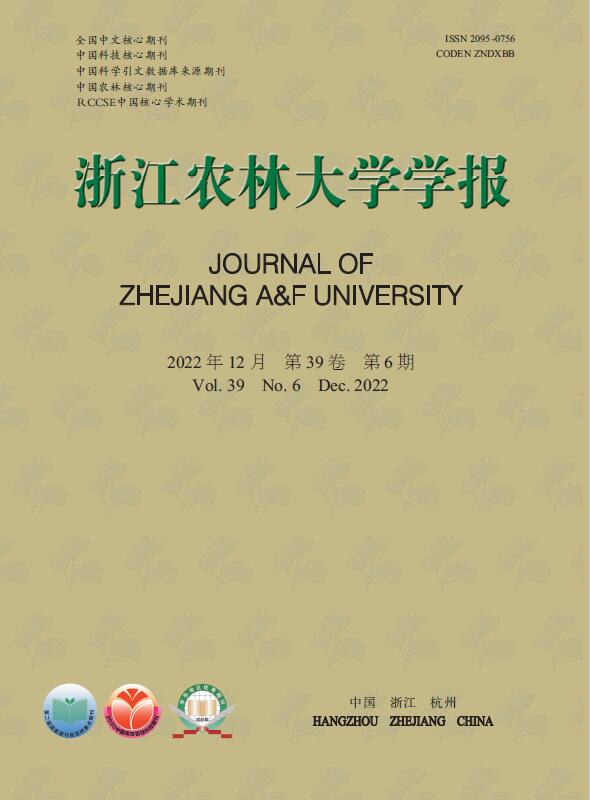










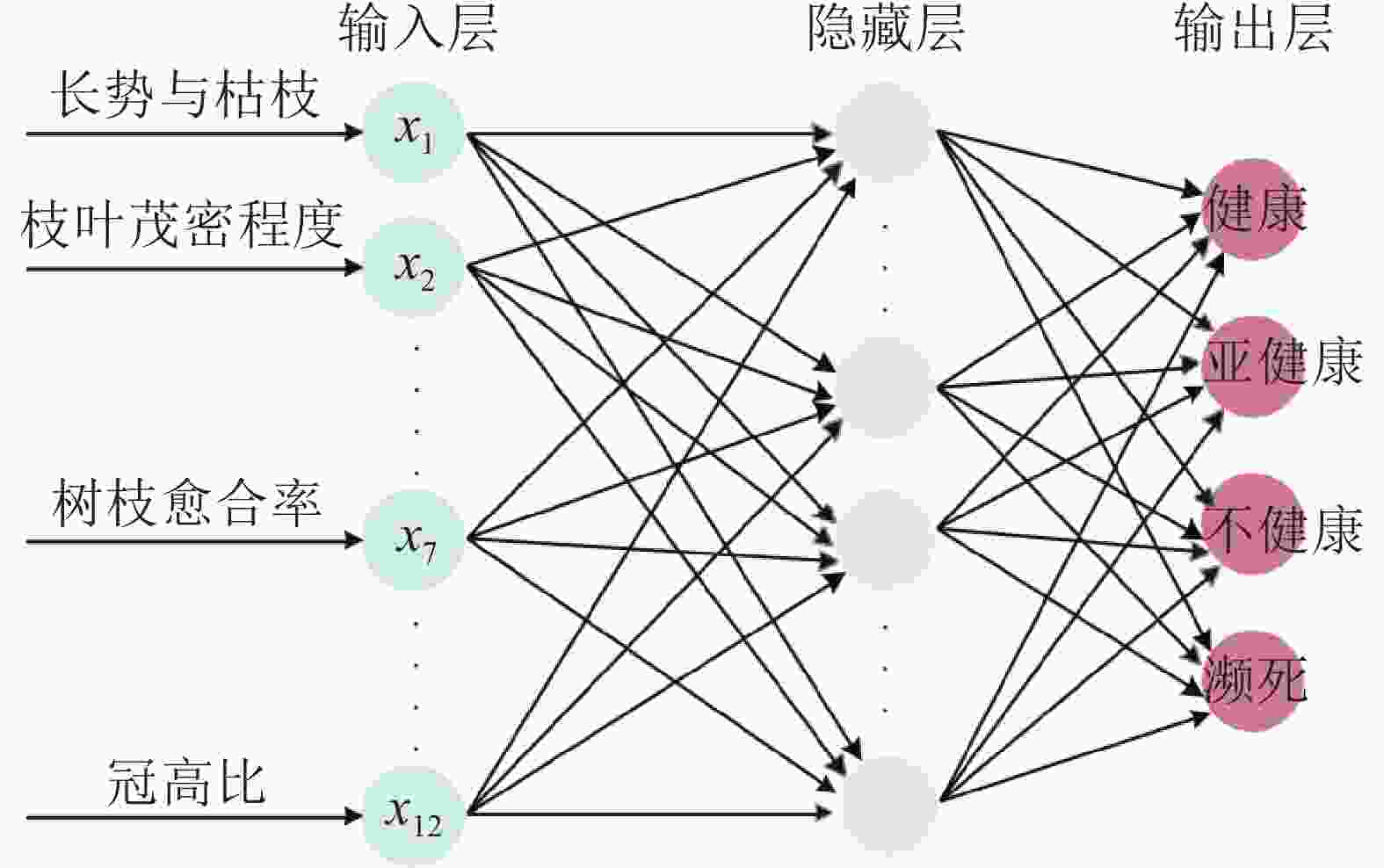

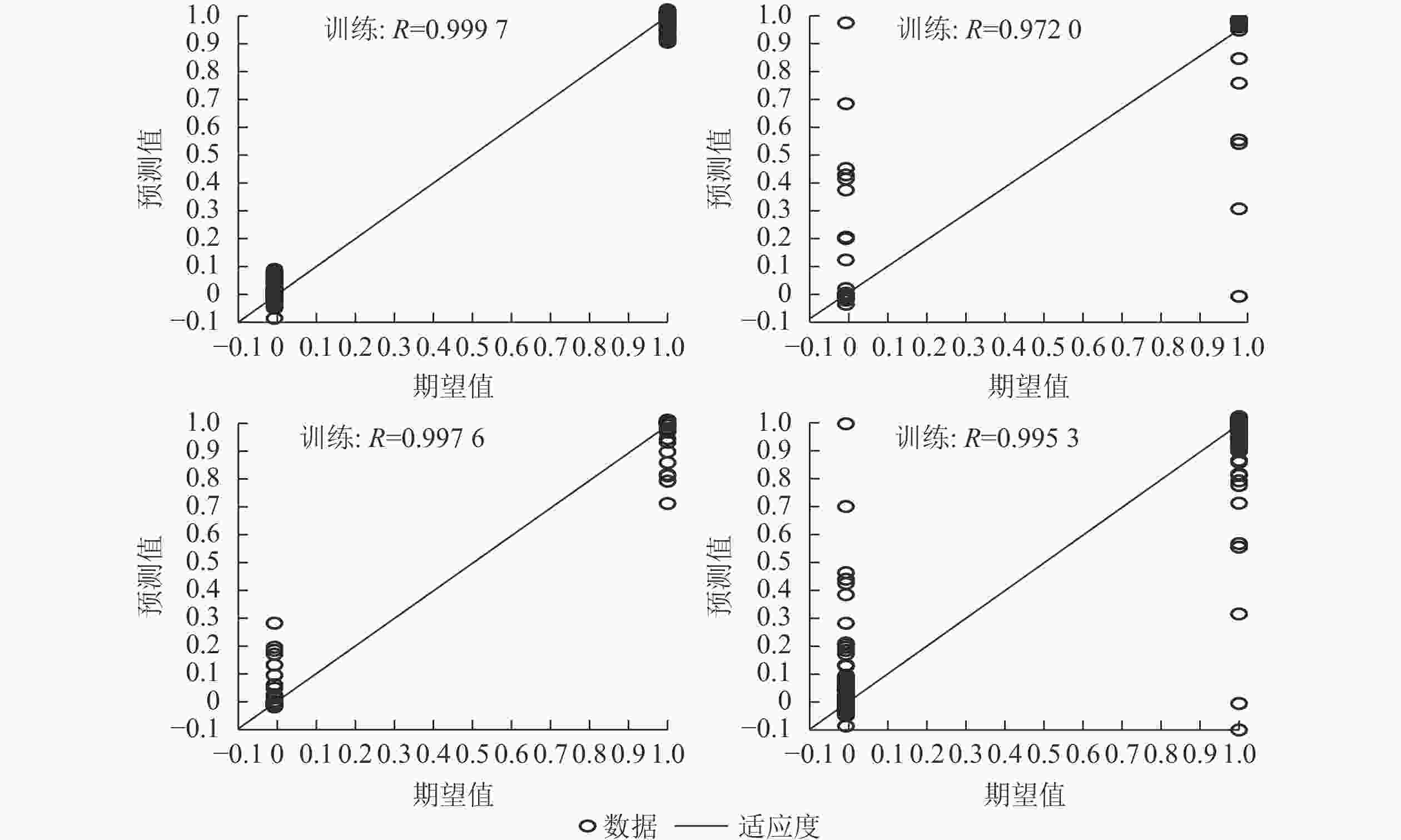
 DownLoad:
DownLoad:
